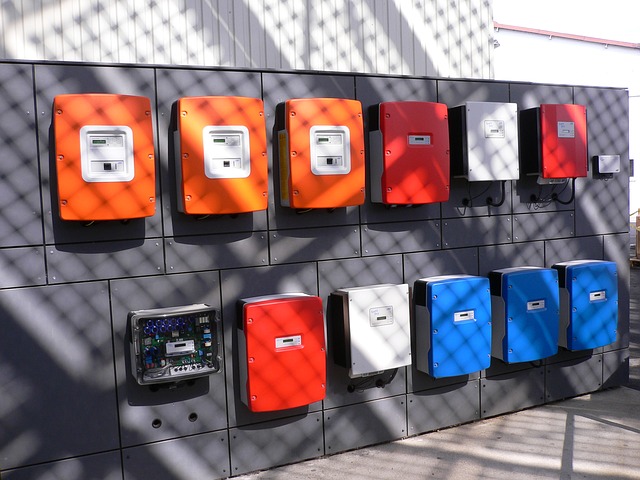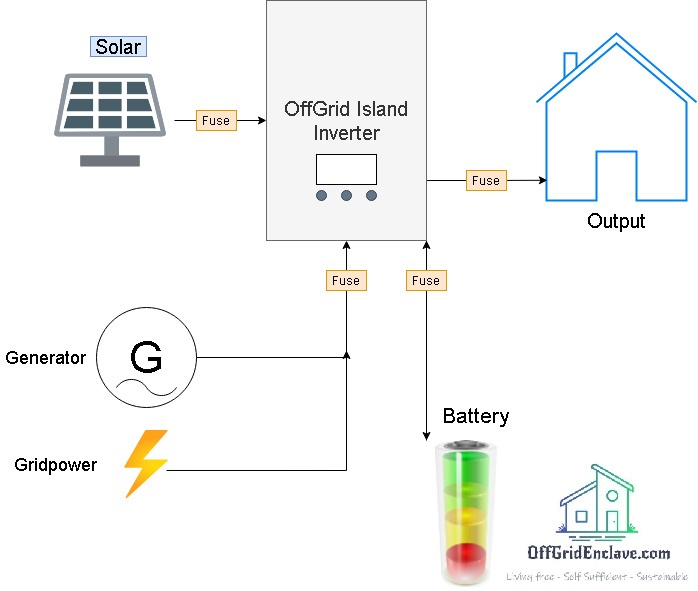Charge Controller and Inverters

OffGrid Inverters
On today’s market you will find plenty of devices that contain all the nessesary main parts in a single housing : a solar-chargecontroller and an inverter, a connection interface and controllers to configure settings, often also with the option to connect a generator or grid power. Usually these are branded as “offgrid inverters”, “solar-island inverters”, “hybrid-inverters” or something along that tone. This makes the setup and installation a lot more easy compared to having all functions as extra devices. Considerable less connections and less possible sources of error. Using one of these devices also makes it easy to have a seamless fallback to gridpower in case of no solar power present and the la batterie beeing emty.

Chargecontroller
An OffGrid power system needs a charge controller to function. The charge controller takes the energy from the solaire panels or wind turbine and converts the voltage so it’s suitable for battery charging and manages the battery levels. When acquiring a charge controller, make sure to check the voltage requirements. Only connect the correct batteries for which the charge controller is designed. Do not connect a lead acid battery to a charge controller designed for Li-ion and vice-versa. This could compromise the safety and lifespan of the batteries as the charge algorithms and voltage settings are different. The solar charge controller is typically rated against Amperage and Voltage. Select the solar charge controller to match the voltage of the solar panels array and batteries. Identify which type of solar charge controller is right for your application. Make sure that solar charge controller has enough capacity to handle the current from the solar panels array.
Types of charge controllers
- PWM charge controllers
A lower-cost charge controller only produces an output voltage when sufficient light is available. With a diminishing light source, the charge controller simply turns off and resumes when sufficient levels of light are present.
Usually PWM charge controllers are more limited with their maximum allowed voltage. - MPPT charge controllers
An advanced charge controller tracks power by measuring the voltage and adjusting the current to get maximum power transfer with prevailing light conditions.
It should be noted that not all MPPT circuits function equally well. Some are coarse and do not respond immediately to light changes.
MPPT charge controllers usually have a lot higher voltage allowed for incoming solar panel arrays.
Onduleur
The inverter will convert the DC power stored within a battery (direct current, 12Volt, 24Volts ou 48 Volts) into AC power (alternating current, 110 /220bois de chauffage fourni à partir d'arbres morts dans la forêt) that can be used to run your household items. Pick a reasonably sized inverter. It is recommended to have at least 2Kw peak power output for anything bigger then a caravan. Calculate all your permanent running devices power need, add your entertainment system wattage on top and throw in a hoovers worth of power consumption. For stand-alone systems, the inverter must be large enough to handle the total amount of Watts you will be using at one time. The inverter size should be 25-30% bigger than total Watts of appliances. In case that the appliance type is a motor or compressor then inverter size should be minimum 2.5 times the capacity of those appliances. Inverters are available either with a pure sine wave output or a more rectangular “modified sine wave”. It is highly recommended to only use pure sine wave inverters, and not the modified sine wave. Don’t go cheap here, most Inverters over the 100€ price tag should be pure sine wave output. The inverter must have the same nominal voltage as your battery.
Inverter types
- Low-frequency inverters
Low-frequency inverters have the advantage in: peak power capacity, and reliability. They are designed to deal with higher power requirements for longer periods of time than high-frequency inverters. They can operate at a peak power which is up to 300% of their nominal power for several seconds, while high-frequency inverters can operate at 200% power for a fraction of a second.
Low-frequency inverters work using powerful transformers, which are more reliable and sturdy than the high-frequency inverter’s MOSFETs that use electronic switching.
The downside is they are much more heavy, have less efficiency and are generally more expensive. - High-frequency inverters
These use electronic switching via MOSFETs circuit boards.
Generally cheaper and much lighter.
Due to the already present microchipboard, these inverters have more advanced features such as USB ports to see statistics.
High-frequency inverters can operate at 200% power for a fraction of a second.
Battery Pulser
A Battery Pulser is a small device that provides a short burst charge with over voltage to a battery that is fully loaded. These devices help prevent sulfation of lead acid batteries. It is recommended to install one to increase the lifespan of your battery. Scale the size according to battery Ah rating.